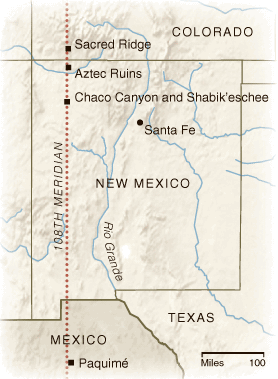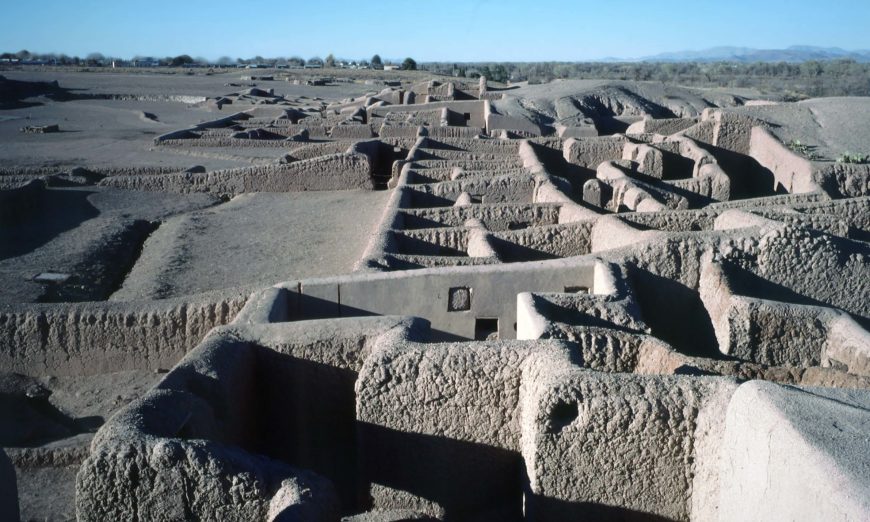
Residential areas, Paquimé (Casas Grandes), c. 1150–1350 C.E., Chihuahua, Mexico (photo: HJPD, CC BY-SA 3.0)
Shell ornaments, copper bells, rubber balls, and macaws are only some of the remarkable finds from the archaeological site of Paquimé (also known as Casas Grandes) in northern Mexico. Some of these things traveled on long-distance trade networks that ran from southern Mesoamerica to what is now the southwestern United States, and west to the Gulf of California. Paquimé was a large city filled with several thousand people that flourished for two centuries, from c. 1150 until about 1350 C.E. It is one of many sites associated with the Mogollon tradition (c. 200–1450 C.E.).
Who and where were the Mogollon?
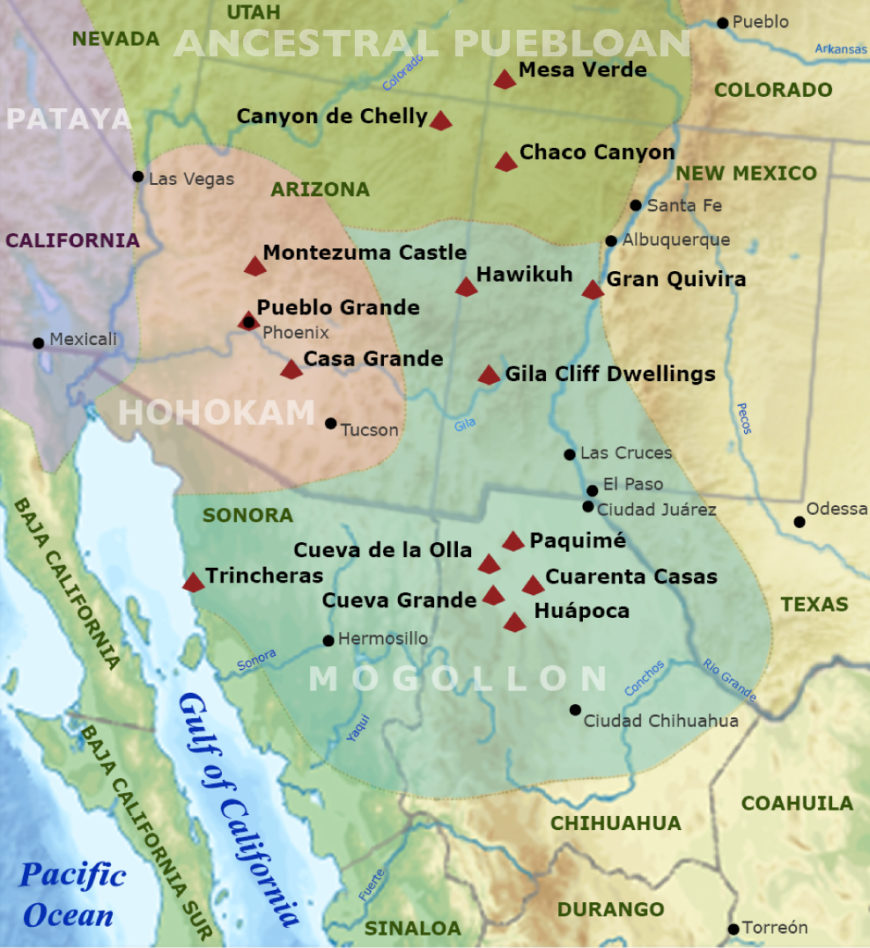
Regions of ancient regional tribes in the southwestern United States and northwestern Mexico (Ricraider, CC BY 3.0)
The Mogollon cultural area spanned across what is today northern Mexico into Arizona and New Mexico. Archaeologists named the Mogollon cultural group after a mountain range in southern New Mexico centuries later. While there are traits that characterize the broader Mogollon tradition, there were distinct features found among six more localized regions (Mimbres, Black River, San Simon, Jornada, Pine Lawn, and Forestdale) in the larger cultural area.
In addition to the Mogollon, the Greater Southwest region included the Hohokam, Ancestral Puebloan, Patayan, and Sinagua cultures. While today scholars tend to discuss them as distinct, it is likely that they are different regional variations and were more entangled than these modern-day divisions suggest.
For reasons still debated, the Mogollon disappear from the archaeological record in the mid-15th century, likely the result of them joining with Pueblo or Hopi villages. Today, multiple Native groups claim descent from the Mogollon or are intertwined with their history, including Zuni, Hopi, Acoma, and the Rarámuri (in Mexico). Apache peoples migrated into the Mogollon area after the 15th century—around the time that the Mogollon stopped appearing in the archaeological record.
Architecture
Existing archaeological evidence indicates that early on, small Mogollon communities were clustered on hilltops in pithouses. These were circular or oval rooms dug into the ground, which helped to maintain a comfortable temperature. Mogollon people practiced agriculture (primarily growing maize, beans, and squash), but also relied on hunting and foraging. Later on, as their numbers grew and they became an even more diverse group, they settled in other types of areas, including valleys. Around the year 1000, Mogollon peoples began to build above ground and made square living spaces. We also find large round ceremonial rooms that have been called “great kivas” beginning around 850, and which could accommodate large gatherings. These great kivas are on a scale similar to the Ancestral Puebloan city of Chaco to the north, which possibly served as a source. The Mogollon great kivas do not include limited entry points that restrict access to them as at Chaco—perhaps suggesting fewer hierarchical social divisions among the Mogollon.
The exact reasons for transformations (such as building above ground) are still debated.
Shared forms, including architectural features, identifiable among the Mogollon, Ancestral Puebloan, and Hohokam peoples indicate they interacted. When Puebloan peoples migrated south in the 13th century—most likely due to drought—we find increased evidence of influence from Puebloan cultures and indicators of Mogollon and Puebloan cohabitation. Sites like Kinishba and Gila Cliff Dwellings (began after 1270) show the influence of Puebloan architectural features. For example, rather than pithouses, we now find above-ground villages built with stone as well as cliff dwellings—both characteristic of their Pueblo neighbors.
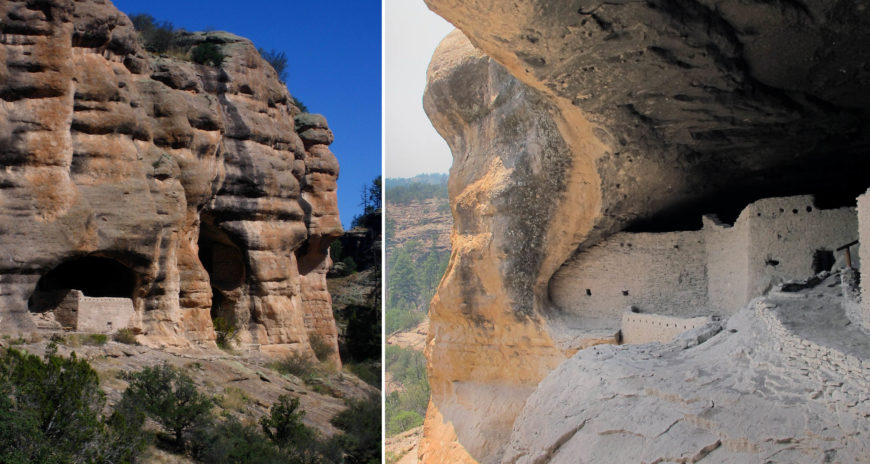
Gila Cliff Dwellings (left photo: Christopher Holden, CC BY-SA 2.0; right photo: cudinski, CC BY-NC 2.0)
Migrations were an important aspect of life at this time, and Pueblo peoples today speak about their ancestors’ migrations, such as the search for the Middle Place. As is clear from what took place in the Greater Southwestern region, people were on the move. The architectural remains of communities at Kinishba and Gila Cliff Dwellings are footprints of these past movements, connecting contemporary Native communities to their ancestors.
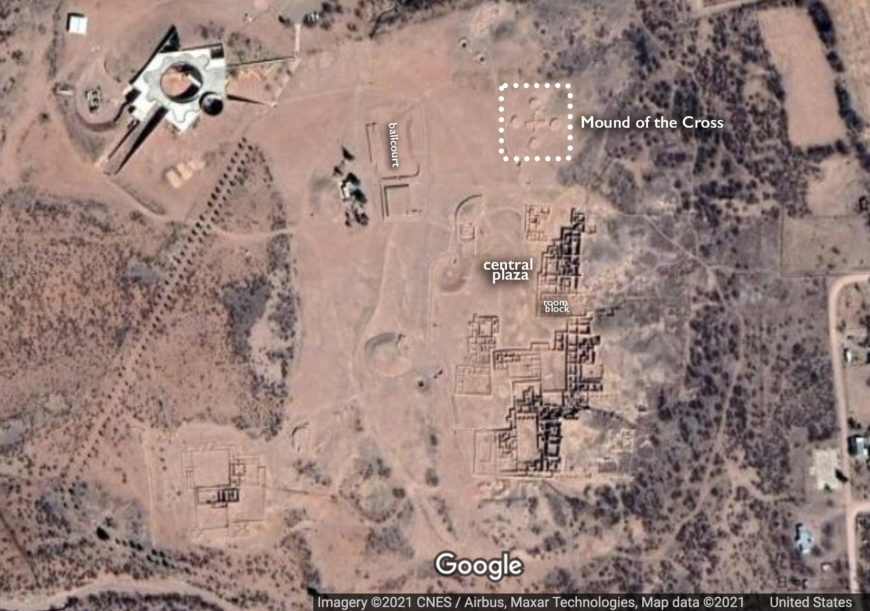
Aerial shot of Paquimé (Casas Grandes), c. 1150–1350 C.E., Chihuahua, Mexico. Only a portion of the site has been excavated (underlying map © Google)
Paquimé
The city of Paquimé, largely built of adobe, would have rivaled other large cities and settlements of the region such as Chaco (which flourished earlier). It had large plazas and marketplaces; big domestic, multistory structures to accommodate its once sizable population (some buildings had 1000+ rooms); at least two ball courts; and platform mounds. One mound, called the Mound of the Cross, has a cross-shaped platform that is oriented toward the four cardinal directions, suggesting it played an astronomical or calendrical role perhaps to track equinoxes and solstices. The exact function of most mounds remains unknown. Feasting areas are filled with huge ovens to be able to cook for large numbers of people. A complex water system brought water from miles away to a reservoir, from where water flowed to the city.
While today the walls of buildings are earthen colored, they were once painted—as was indicated by the Spaniard Baltasar de Obregón, who first saw Paquimé in 1565, after the city was abandoned:
[There are] many houses of great size, strength, and height. They are about six and seven stories. . . . The houses contain large and magnificent patios paved with enormous and beautiful stones resembling jasper . . . and pillars of heavy timber brought from far away. The walls of the houses were whitewashed and painted in many colors. Baltasar de Obregón [1]
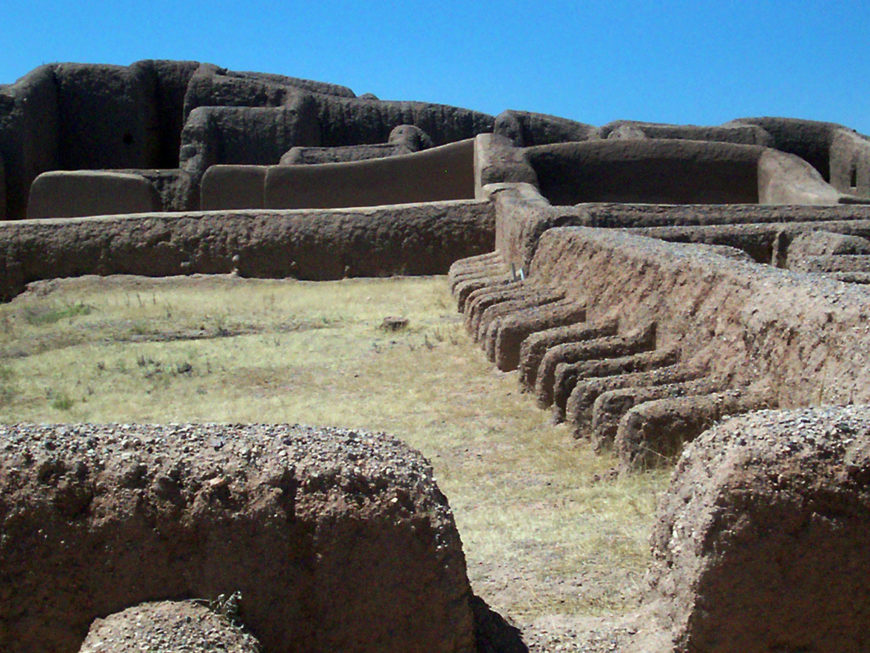
Macaw pens, Paquimé (Casas Grandes), c. 1150–1350 C.E., Chihuahua, Mexico (photo: DiSchamelrider, CC0)
Earlier archaeologists believed Paquimé was an outpost for Mesoamerican peoples (such as the Toltec) but that idea is no longer widely supported. Still, there is clear evidence for long-distance trade with Mesoamerica and the influence of ideas and practices (such as the ballgame), but also trade with coastal regions and those to the east. Macaws, brought from far south, were not only brought here, but the people of Paquimé bred them as revealed by pens found along the plazas (turkeys were also bred here). Shell and copper were imported. We also find iconographic elements popular in Mesoamerica, such as a plumed or horned serpent. Turquoise that was traded south into Mesoamerica moved through Paquimé. The city participated in a network of sites that traded and interacted with one another across vast distances for prestige materials and desired resources.
Paquimé (Casas Grandes), c. 1150–1350 C.E., Chihuahua, Mexico
Paquimé is typically associated with Mogollon culture, but it also had connections to developments in what is today El Paso, Texas. Some consider it a Mogollon city, while others hold that it had its own unique culture and simply traded and interacted with Mogollon people. Paquimé also shares cultural features with Chaco, leading archaeologist Steven Lekson to argue that Chacoan elites established Paquimé after migrating south. The two sites (along with the site of Aztec in New Mexico—not to be confused with the Mexica/Aztec culture) are close to the same meridian line (what Lekson has dubbed the Chaco Meridian), suggesting that people intentionally sought to connect them. Regardless of which of these ideas is true, Paquimé certainly was the largest, most complex city associated with the Mogollon tradition.
For reasons that remain elusive, Paquimé seems to have been abandoned after 1400. Despite the city’s size and complexity, it has been much less studied than sites within U.S. borders—despite being part of the Greater Southwest region—and is a reminder that modern-day nation state boundaries have implications for what and how things are studied.

Mimbres bowls, c. 8th–12th century. Left: Bowl, c. 1000–1200, clay, slip, paint, 13 cm high, 27.9 cm in diameter (The Metropolitan Museum of Art); center: Bowl, c. 850–1050, clay, slip, paint, 8.3 cm high, 55.9 cm in diameter (The Metropolitan Museum of Art); right: Bowl, c. 1000–1200, clay, slip, paint, 11 x 24 cm (NMAI, New York)
Mimbres pottery
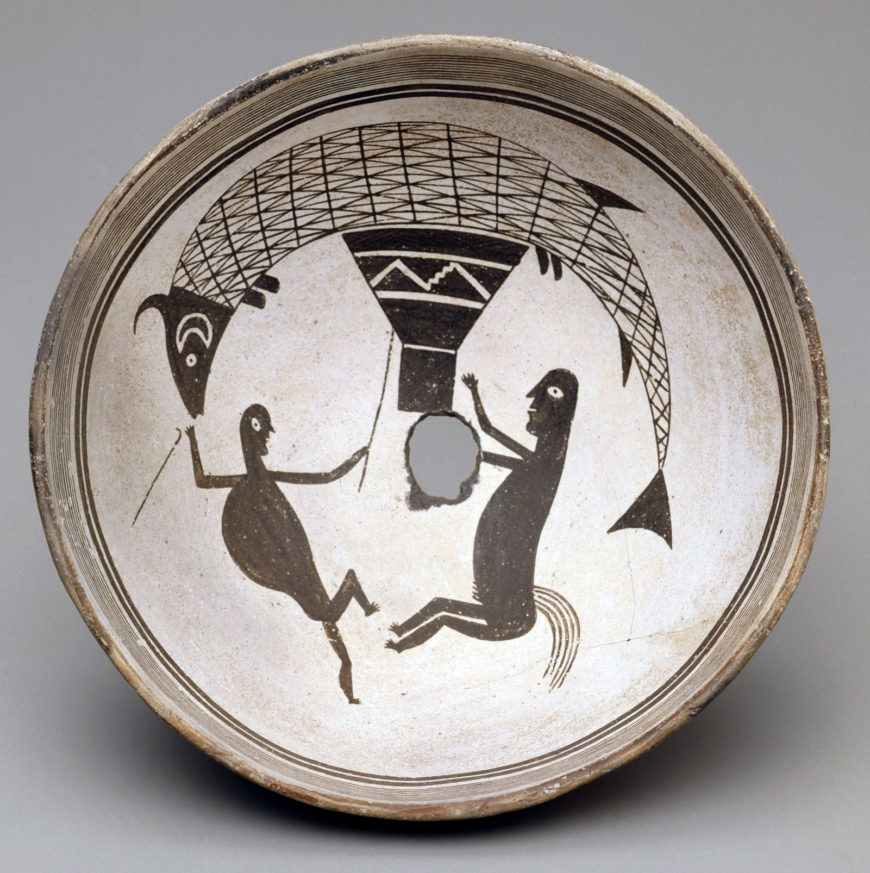
Bowl, Mogollon (Mimbres), 1100–1400, clay, slip, paint, 10.2 x 26.7 cm (Detroit Institute of Arts)
Mogollon ceramics are some of the finest examples of pottery from the Greater Southwest region. Pottery initially took the form of red-on-brown or plain brown wares before black-on-white (black paint on white slip) became popular by 1000. Mogollon pottery makers used a coil and scrape technique, created by coiling the clay, then scraping the exterior and interior to join the coils together, and finally creating a smooth surface.
There are different types of Mogollon pottery, but the tradition associated with Mimbres culture is the most well-known. Classic Mimbres pottery (1000–1150) has some of the most inventive and diverse subject matter depicted on it, ranging from geometric patterns to narratives with figures; the latter have sometimes been called “story bowls.” Animals and birds of wonderful variety grace the bowls, as do humans who fight, farm, hunt, give birth, and many other activities. Hybrid or sacred creatures, such as horned serpents or animal-human hybrids adorn Mimbres pottery.
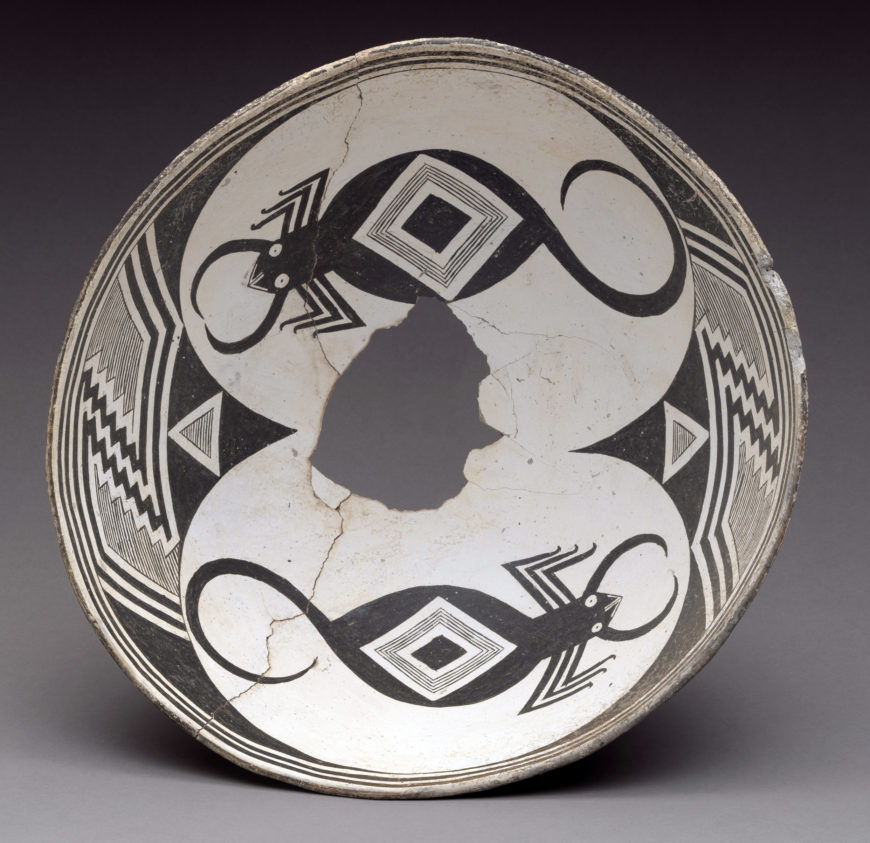
Bowl with scorpions, c. 950–1150 C.E., Mogollon (Mimbres), ceramic and pigment, 14.9 cm high, 34.6 cm in diameter (The Metropolitan Museum of Art)
In one we see two scorpions, their tails looping backwards towards their bodies, with their eyes wide open. Abstract patterns surround the black arachnids, both of which are set on a white background. The artist used the shape of the bowl to her advantage, positioning the scorpions so that they “read” clearly. She also created precise forms and a balanced composition, positioning the scorpions and abstract designs on opposite sides of the bowl. The black arachnids are set against a field of white, drawing our eye to them, at the same time that the abstract designs frame the fields of white.
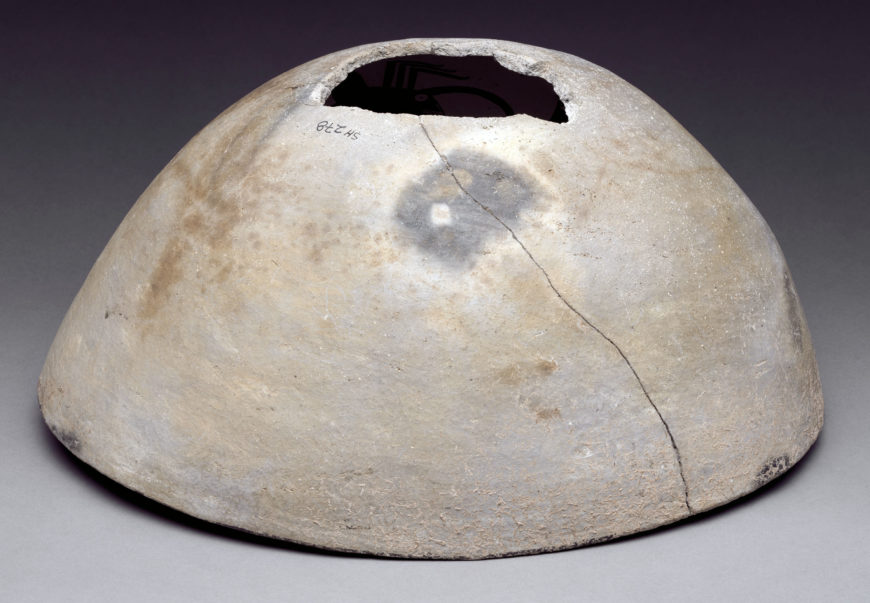
Bowl with scorpions, c. 950–1150 C.E., Mogollon (Mimbres), ceramic and pigment, 14.9 cm high, 34.6 cm in diameter (The Metropolitan Museum of Art)
Typically painted on hemispheric bowls, Mimbres pottery survives in great numbers—more than 10,000 bowls survive—and many are found largely intact. The bowls were found in burials, but because they were desired as artistic objects, were removed from these graves, with little concern for the deceased ancestors and their family members and communities.
Many Mimbres bowls show light wear-and-tear, suggesting they were used (possibly in food preparation) before going underground. Most of the bowls have a hole in the base of the bowl, such as we see in the bottom of the scorpion bowl. While we do not know the exact purpose of the hole, two possibilities are that it aided the soul of the deceased by providing a path or that the hole silenced the life force or spirit of the bowl. The bowl was often placed over the face of the deceased, which echoes contemporary Pueblo accounts of the dead going to the dome of the sky as spirits. [1]
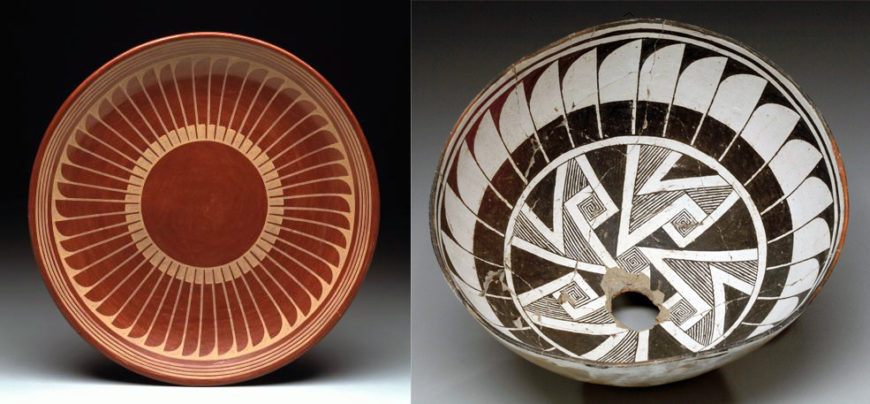
Left: María Martinez and Popovi Da (both from San Ildefonso Pueblo), Plate with radiating feather design, 1960s, ceramic, 5.08 cm high, 40.64 cm in diameter (Dallas Museum of Art); right: Bowl, Mogollon (Mimbres), c. 1000–1150, ceramic, slip, and paint, 15.6 cm high, 29.84 cm in diameter (Dallas Museum of Art)
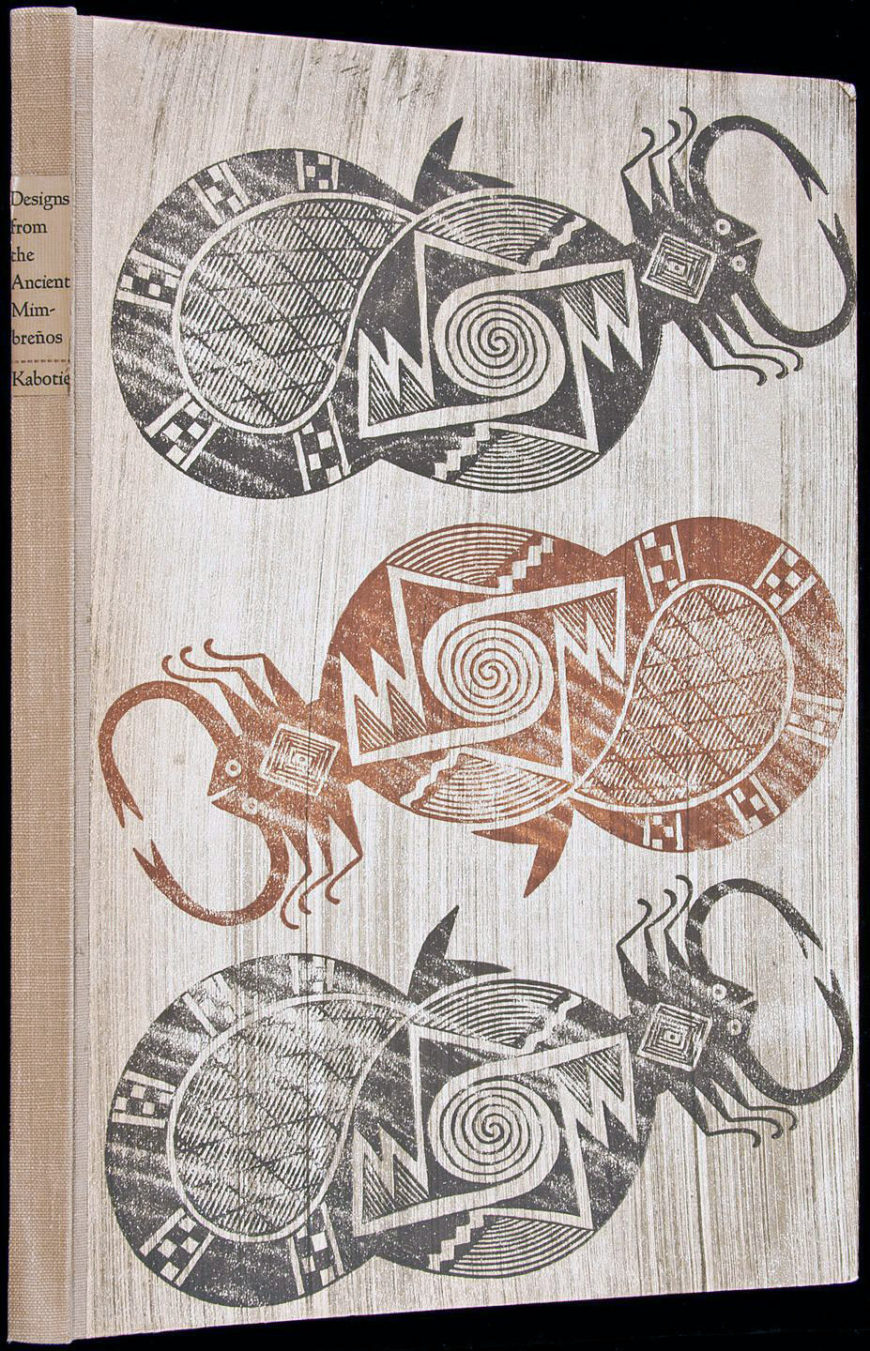
Fred Kabotie, Designs from the ancient Mimbreños, with a Hopi interpretation (San Francisco: Grabhorn Press, 1949)
Multiple early 20th-century Native artists and textile makers have found inspiration in and connections with Mimbres pottery, including Maria and Julian Martinez and their son Popovi Da and grandson Tony Da from San Ildefonso Pueblo, Hopi artist Fred Kabotie, Joe Herrera (also known as See Ru; Cochiti Pueblo), Lucy Lewis (from Acoma Pueblo), and Anishinaabe/Ojibwe artist Carl Beam. For example, a bowl by Popovi Da has radiating feathers that replicate the rhythmic geometric patterning of some Mimbres bowls, yet demonstrates the adaptability of the tradition by 20th-century Native artists. Kabotie wrote and illustrated a book called Designs from the Ancient Mimbreños with a Hopi Interpretation, which looked to the ways in which Hopi and Mimbres designs and ideas intersected.
Unfortunately, many Mimbres bowls were looted in the late nineteenth and early twentieth centuries. As more Euro-Americans came to the region, they began to dig up the pots. The desecration was so extreme that most Mimbres villages—of which there are about 900 examples—were heavily damaged or destroyed. Besides looting, forgeries also became common.
By the 1930s, Mimbres bowls were so famous that when they traveled to Europe, some, such as the anthropologist Albert Jenks, pronounced them to be “unquestionably superior to Greeks in the field of Geometric Art.” [2] This quote suggests that people compared Mimbres to ancient Greek art as a way to elevate this Native American group, but also to position America’s history over Europe’s. The bowls became evidence of civilized peoples living in the U.S. before it was colonized by settlers, although simultaneously, people characterized the rest of the southwest area as “primitive”—and so understood Mimbres as different, as “an isolated artistic miracle.” [3] They became what art historians Janet Catherine Berlo and Ruth B. Philips call an “emblem of Indianness” along with Northwest Coast totem poles and Plains war bonnets. [4]
Mimbres vessels also became championed as bold sources for modern design, and were included in exhibitions such as the Museum of Modern Art’s 1941 Indian Art of the United States—their designs were even painted on the walls. Even today, many museum collections and exhibitions showcase Mimbres bowls, with little of the rest of Mogollon art visible or heralded.
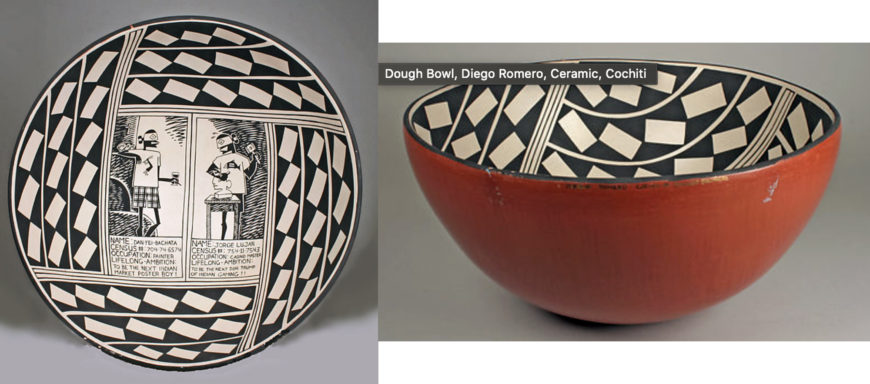
Diego Romero (Cochiti Pueblo), Dough Bowl, 1994, ceramic, 14.3 cm high, 30.5 cm in diameter (The Metropolitan Museum of Art)
Today Native artists continue to find inspiration in Mimbres pottery, including Cochiti artist Diego Romero. His Dough Bowl combines an aesthetic adapted from Mimbres bowls with imagery from popular culture. Two figures appear in the center, with text below stating their name, census number, and occupation, with a statement about their lifelong ambition. It is intended to be comical, biting commentary on contemporary Native issues. [5]
Mimbres bowls have become so ubiquitously associated with this region, that they also appear on place settings, aprons, postcards, and more. They were even part of a stamp set from the US Postal Service in 2004.
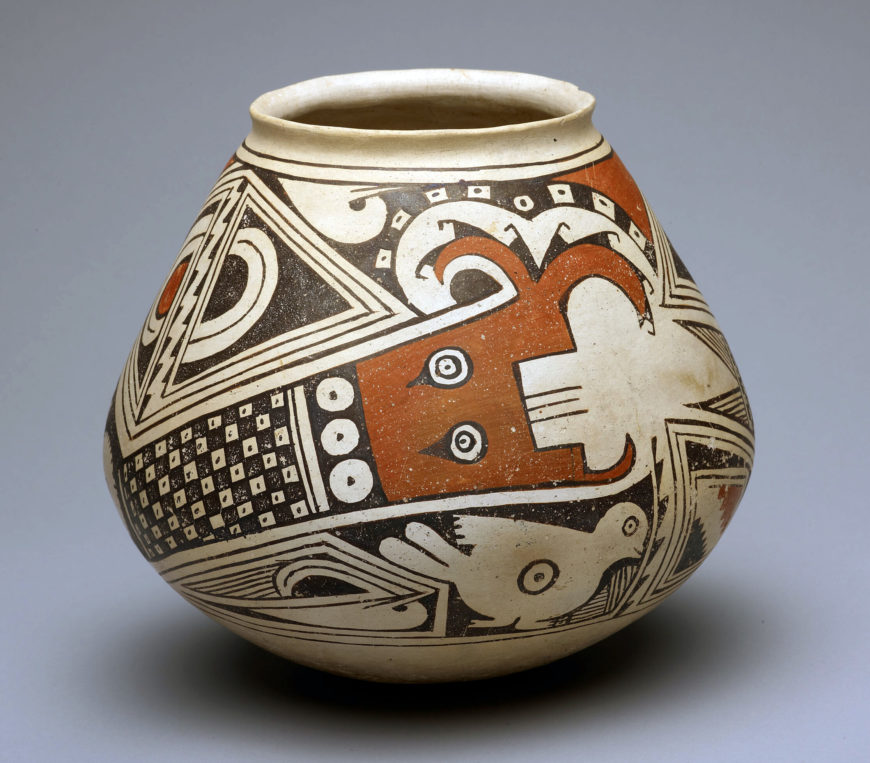
Jar with Two Plumed or Horned Serpents with Birds and P-shaped Motifs, 1280–1450, ceramic and pigment, Paquimé (Casas Grandes), Ramos Polychrome, New Mexico, U.S. or Chihuahua, Mexico, 21.6 x 24.1 cm (Art Institute of Chicago)
Paquimé ceramics
The pottery affiliated with Paquimé demonstrates the wide variety of vessels in the Mogollon region. It began c. 1250 and lasted for the next two hundred years. Unlike Classic Mimbres bowls, Paquimé ceramics appear in a variety of different shapes and sizes (such as tripods, globular jars, bowls, and more), and are polychromed. Like Classic Mimbres, they display both geometric abstraction and figural forms. In one, two horned serpents zig-zag across the elaborate surface, their head and horns painted red. Their bodies are covered in black-and-white checkerboard designs, mimicking the scales of a serpent.
Horned or feathered serpents decorate not only pottery but also rock art and kiva murals. The horned serpent is not unique to Mogollon, but is found in Ancestral Puebloan regions as well. Among Pueblo groups today, the horned serpent is an important deity (going by different names depending on the linguistic group) associated with water. They are liminal beings who can move into the earth as well as slither on top of it. The horned serpent also relates to feathered serpents, with the horns possibly relating to plumes; the avian association is likewise important because birds could move between the surface of the earth and the sky.
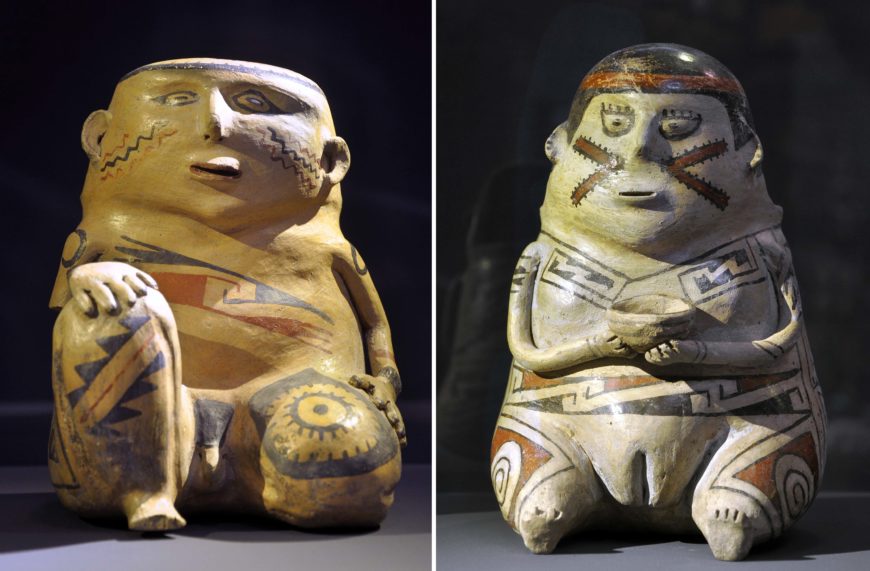
Male effigy figure, Paquimé (Casas Grandes), Ramos polychrome, c. 1200–1450 (Musées Royaux d’Art et d’Histoire, Brussels); right: Female effigy figure, Paquimé (Casas Grandes), Ramos polychrome, c. 1200–1450 (Musées Royaux d’Art et d’Histoire, Brussels)
We also find jars modeled into figural shapes, such as humans or animals. Seated male and female figures (what we now call effigy figures) are common, and are thought to convey ideas about gendered principles. Their genitalia are always displayed and often accentuated with design and color. Male figures tend to sit with one bent knee, while women sit with both legs straight. Women sometimes have protruding bellies or are shown with children, which has prompted scholars to think that they may have symbolized ideas about fertility. The bodies of figures often display elaborate designs—does this suggest that people had tattoos? Painted their bodies? Or does the bodily adornment of the effigies suggest something else? Researchers are not certain, but it does seem important that figures are also adorned with different types of clothing and accoutrements, such as necklaces, bracelets, ear ornaments, and armbands. The bodily decorations, clothing, and accoutrements may have signified different social ranks.
Twentieth-century artists have likewise been inspired by Casas Grandes pottery, such as Juan Quezada Celado of Mata Ortiz, Chihuahua. After encountering and studying pottery fragments, he taught himself how to pair what he saw with his own modernist impulses. The town of Mata Ortiz went on to develop a robust local pottery tradition in conversation with Paquimé pottery.
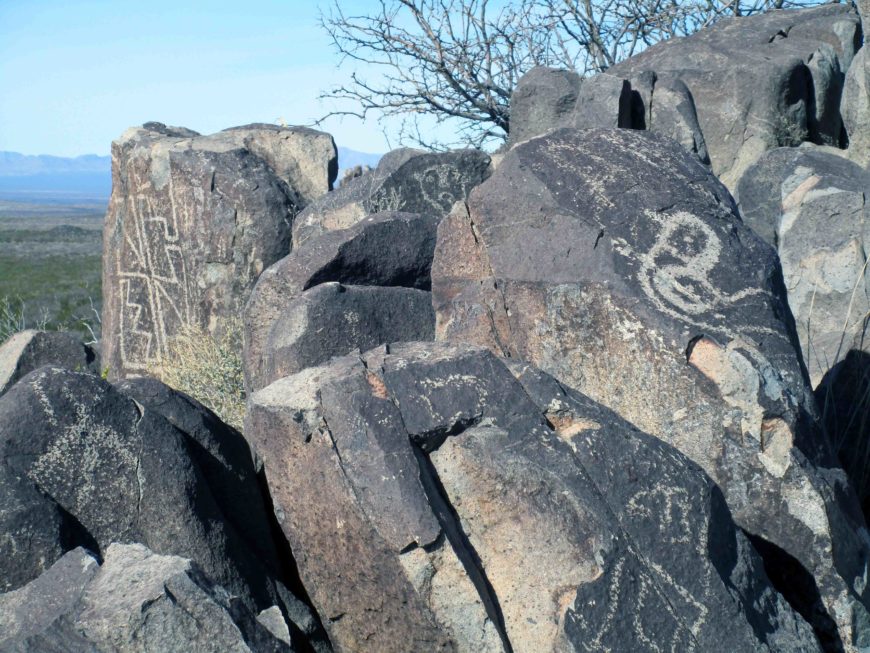
Three Rivers Petroglyph Site, Mogollon (Jornada), c. 900–1400, New Mexico(photo: jaygannett, CC BY-SA 2.0)
Petroglyphs and rock paintings
The Mogollon peoples also produced a great deal of rock art, such as at Three Rivers Petroglyph site where there are more than 20,000 petroglyphs made between 900–1400. While to visitors today many such sites might seem remote and isolated, these petroglyphs were part of a dynamic landscape, one that would been dotted with pithouses, many of which have since returned to the earth. Besides carving into living rock, Mogollon people also painted on them.
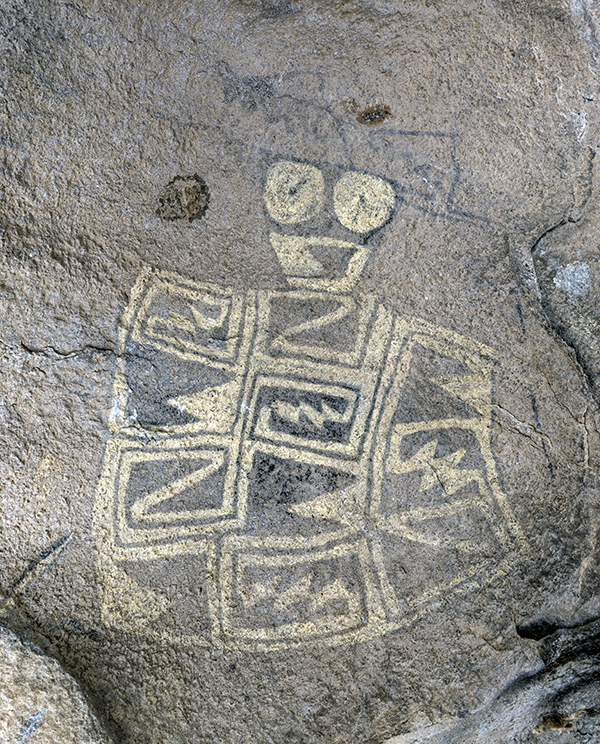
Rock drawings, or pictographs, in a restricted area of Hueco Tanks State Historic Site near El Paso in El Paso County, Texas, photograph by Carol M. Highsmith (Library of Congress, Prints and Photographs Division
At Hueco Tanks, sacred for the Jornada branch most likely, we find pictographs and paintings that adorn the walls of caves, such as birds, humans, and what are identified as masks. Many of the figures have been compared to Mesoamerican deities such as Quetzalcoatl and Tlaloc because they seem to have goggle eyes or feathered/horned serpents; as was discussed above though, figures like horned serpents were important to peoples across the Greater Southwest.
Multiple descendant groups still consider Hueco Tanks a sacred place; it is one of many footprints in the region that connect contemporary communities with their ancestors. The rock art also testifies to the important and long-standing relationship to place among Native communities in the region. Some of this stunning visual record is at risk, whether from vandalism, areas targeted for development, erosion, or industrial pollution.
A dynamic tradition
The Mogollon tradition was both diverse, expansive, and vibrant. Some of it has been destroyed or is at risk of destruction, threatening to partially erase some of the inventive and original architectural and artistic traditions are ancestral footprints and sacred nodes for multiple Native communities today.
Notes:
[1] Janet Catherine Berlo and Ruth B. Phillips, Native North American Art (Oxford: Oxford University Press, 2015), p. 56
[2] Albert Ernest Jenks, “Geometric designs on Mimbres bowls,” Art and Archaeology 33, no. 3 (1932): p. 137
[3] Stephen H. Lekson, “Mimbres art and archaeology,” in Archaeology, Art, and Anthropology: Papers in Honor of J.J. Brody, edited by M. S. Duran and D. T. Kirkpatrick. Papers of the Archaeological Society of New Mexico, vol. 18. (Archaeological Society of New Mexico, Albuquerque, 1992), p. 214
[4] Berlo and Phillips, Native North American Art, p. 54
[5] See Gaylord Torrance, et al., Art of Native America: The Charles and Valerie Diker Collection (New York: The Metropolitan Museum of Art, 2018).
Additional resources
Michele Beltrán, Virginia M. Fields, Victor Zamudio-Taylor, The Road to Aztlan: Art from a Mythic Homeland (Los Angeles: Los Angeles County Museum of Art, 2001)
Tony Berlant, Evan M. Maurer, Anthony Berlant, Decoding Mimbres Painting: Ancient Ceramics of the American Southwest (Los Angeles: Los Angeles County Museum of Art, 2018)
Burrison, John A. Global Clay: Themes in World Ceramic Traditions (United States: Indiana University Press, 2017)
John Kantner, Ancient Puebloan Southwest (Cambridge: University Press, 2004)
Stephen H. Lekson, The Chaco Meridian: One Thousand Years of Political and Religious Power in the Ancient Southwest, 2nd ed. (Rowman & Littlefield, 2015)
Marit K. Munson,The Archaeology of Art in the American Southwest (AltaMira Press, 2011)
Tessie Naranjo, “Thoughts on Migration by Santa Clara Pueblo,” Journal of Anthropological Archaeology 14 (1995), 247–249.
David Grant Noble, Ancient Ruins and Rock Art of the Southwest: An Archaeological Guide (United Kingdom: Taylor Trade Publishing, 2015)
Polly Schaafsma, Indian Rock Art of the Southwest (School of American Research, 1986)


